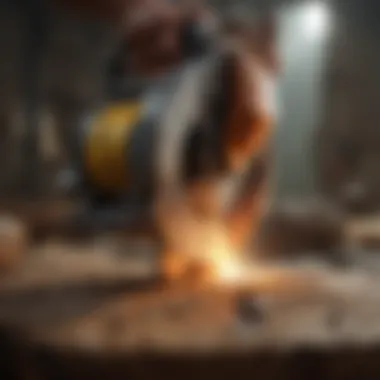Mastering the Art of Using Hand Rock Saw: A Detailed Guide for Precision and Efficiency


Rock and Fossil Identification
In the realm of rock and fossil identification, it is crucial for collectors to familiarize themselves with the various types of rocks and fossils in order to distinguish and appreciate their unique characteristics. Rocks can vary from sedimentary to igneous to metamorphic, each exhibiting distinct textures and composition. Fossils, on the other hand, provide invaluable insights into prehistoric life and can range from imprints to petrified remains. Understanding the characteristics to look for, such as color, pattern, and structure, can aid collectors in identifying and categorizing their findings. To aid in the identification process, collectors rely on tools such as magnifying glasses, scratch tests, and ultraviolet lights to examine and authenticate their discoveries.
Introduction
In this comprehensive guide titled 'Exploring the Art of Using Hand Rock Saw,' we extensively delve into the intricate world of utilizing a hand rock saw. From dissecting the basic principles to mastering advanced techniques, this article aims to provide rock and fossil collectors with valuable insights into enhancing precision, efficiency, and safety in cutting and shaping geological specimens. Whether you are a novice seeking to grasp the fundamentals or a seasoned collector looking to refine your skills, this guide offers a detailed exploration of techniques, safety measures, and practical applications for optimal rock and fossil pursuits.
Understanding the Significance of Hand Rock Saws
The Evolution of Rock Cutting Tools
When examining the evolution of rock cutting tools, it becomes evident that technological advancements have played a pivotal role in shaping the efficiency and precision of cutting methods. From the rudimentary tools of the past to the sophisticated hand rock saws available today, the evolution has revolutionized the way geological specimens are prepared and shaped. The key characteristic of these modern tools lies in their ability to provide unparalleled accuracy and control, greatly benefiting users in achieving intricate cuts with finesse. The unique feature of modern rock cutting tools is their adaptability to various types of rocks, making them a versatile and indispensable choice for rock and fossil collectors.
Importance in Geological Specimen Preparation
Hand rock saws hold immense significance in the realm of geological specimen preparation due to their precision and efficiency in cutting and shaping rocks. They play a crucial role in ensuring that specimens are carefully dissected and presented for further analysis or display. The key characteristic of hand rock saws in this regard is their ability to handle delicate specimens with minimal damage, preserving the integrity of geological samples. The unique feature of these saws is their contribution to enhancing the accuracy and detail in geological specimen preparation processes, making them a popular choice among collectors and researchers seeking optimal outcomes.
Overview of Hand Rock Saw Techniques
Basic Principles of Cutting
The basic principles of cutting with hand rock saws encompass fundamental techniques that form the foundation of precise rock shaping. These techniques involve understanding the composition of different rocks, selecting the appropriate blade materials, and executing controlled cutting motions. The key characteristic of basic cutting principles is their emphasis on safety, accuracy, and efficiency in achieving clean cuts. Their unique feature lies in their accessibility to beginners, allowing them to grasp essential cutting skills and foundational knowledge required for advanced rock cutting methods.
Advanced Precision Methods
Advanced precision methods in hand rock saw usage showcase intricate techniques designed to elevate the quality and precision of cuts. These methods involve specialized cutting approaches geared towards creating complex shapes, intricate designs, and customized specimens. The key characteristic of advanced precision methods is their attention to detail and meticulous craftsmanship, resulting in refined and polished geological samples. Their unique feature lies in their ability to cater to experienced collectors seeking to push the boundaries of creativity and precision in rock and fossil cutting.
Safety Precautions and Equipment
Protective Gear


Protective gear forms a crucial aspect of ensuring safe hand rock saw usage, safeguarding users against potential hazards during cutting and shaping activities. Proper eye protection, durable gloves, and protective clothing are essential components of protective gear that mitigate risks of injury. The key characteristic of quality protective gear is its durability and ergonomic design, providing users with comfort and protection throughout cutting sessions. Its unique feature lies in enhancing user confidence and safety, enabling uninterrupted and secure operation of hand rock saws.
Proper Handling and Maintenance
Proper handling and maintenance practices are paramount in prolonging the lifespan and performance of hand rock saws. Regular blade inspections, lubrication of moving parts, and correct storage procedures contribute to the longevity and optimal functioning of these tools. The key characteristic of proper handling and maintenance is its ability to prevent premature wear and tear, ensuring consistent cutting performance. Its unique feature lies in promoting efficiency and longevity of hand rock saws, allowing collectors to maximize their utility and value over time.
Choosing the Right Hand Rock Saw
In the comprehensive guide of Exploring the Art of Using Hand Rock Saw, the section on choosing the right hand rock saw plays a crucial role. When it comes to rock and fossil collecting, selecting the appropriate hand rock saw can significantly impact the quality and precision of cutting and shaping geological specimens. This section provides valuable insights into key elements, benefits, and considerations related to choosing the right hand rock saw.
Factors to Consider
Blade Material and Size
Discussing the blade material and size is essential in the context of hand rock saw selection. The blade material determines the saw's durability, cutting efficiency, and precision. Opting for high-quality diamond blades, known for their hardness and resistance to abrasion, can ensure smooth and precise cuts on various types of rocks and fossils. Additionally, considering the size of the blade in relation to the intended use is vital. Larger blades are suitable for cutting through larger rocks, while smaller blades offer more precision for intricate cuts.
Portability and Versatility
Another critical factor to consider is the portability and versatility of the hand rock saw. For collectors who work in diverse locations or field settings, a portable and versatile saw can enhance mobility and convenience. Choosing a saw that is lightweight, easily transportable, and adaptable to different cutting angles can optimize efficiency and usability during expeditions or fieldwork.
Top Hand Rock Saws on the Market
When analyzing the top hand rock saws available on the market, a detailed comparison of features is essential to make an informed decision. Understanding the characteristics and functionalities of different saw models can help collectors identify the most suitable option for their specific requirements.
Feature Comparison
Conducting a thorough feature comparison allows collectors to assess factors such as power, blade type, cutting capacity, and additional functionalities offered by various hand rock saw models. Comparing aspects like motor power, blade adjustability, cutting speed, and compatibility with different materials can guide collectors in selecting a saw that meets their cutting needs effectively.
User Reviews and Recommendations
Exploring user reviews and recommendations provides valuable insights into the practical performance and user satisfaction levels of different hand rock saws. By paying attention to feedback regarding durability, cutting precision, ease of maintenance, and overall user experience, collectors can gauge the reliability and suitability of specific saw models for their rock and fossil cutting projects.


Techniques and Best Practices
In the realm of utilizing a hand rock saw, mastering techniques and best practices is paramount to achieving precision and efficiency. This section delves deep into the nuances of employing these skills to enhance rock and fossil cutting endeavors. By understanding and implementing proper techniques, collectors can elevate their craftsmanship and ensure optimal results. The importance of this topic lies in the foundation it provides for achieving mastery in the art of using a hand rock saw. Techniques encompass a wide array of methods, ranging from basic cutting principles to advanced shaping techniques. Each practice holds significance in contributing to the overall quality and finesse of the final geological specimens.
Basic Cutting Methods
Straight Cuts
Straight cuts play a pivotal role in the process of shaping geological specimens with a hand rock saw. Their precision and uniformity are crucial in creating clean and defined lines on rock surfaces. The key characteristic of straight cuts is their ability to slice through materials seamlessly in a linear fashion, ensuring a professional finish. This method is a popular choice for its simplicity and effectiveness in achieving streamlined cuts with minimal wastage. While straight cuts excel in precision and consistency, their inherent drawback lies in their limitation when intricate curves or designs are required, making them more suitable for straightforward cuts that prioritize straight edges.
Curved Cuts
Conversely, curved cuts offer a different dimension to the cutting process, allowing for the creation of more intricate and organic shapes in geological specimens. The key characteristic of curved cuts is their versatility in sculpting curves and contours with finesse, adding depth and dimension to the final design. Their unique feature lies in the ability to follow natural formations within the rock or fossil, enhancing the aesthetic appeal of the specimen. While curved cuts excel in creating visually captivating shapes, they can be more challenging to execute with precision compared to straight cuts. Mastery of curved cuts requires finesse and practice to achieve smooth and flawless results.
Advanced Shaping Techniques
Fossil Preparation
Fossil preparation is a specialized technique that focuses on extracting and showcasing fossils embedded within rock formations. This aspect is crucial in geological specimen preparation as it preserves the integrity and aesthetic value of the fossil while accentuating its details. The key characteristic of fossil preparation is its meticulous approach to revealing fossils without causing damage, emphasizing careful precision and patience. This method is a popular choice among collectors for its ability to uncover hidden treasures within geological samples while maintaining their structural integrity. A unique feature of fossil preparation is its delicate nature, requiring intricate tools and techniques to safeguard the fossil during extraction and cleaning.
Customized Designs
Customized designs offer a creative outlet for collectors looking to sculpt unique patterns and motifs into their rock or fossil specimens. The key characteristic of customized designs is the freedom it provides to personalize geological samples according to individual preferences and artistic visions. This method is a beneficial choice for enthusiasts seeking to impart a distinctive touch to their collection, adding a layer of artistry to the specimens. Customized designs offer a playground for creativity and experimentation, allowing collectors to explore various shaping techniques and styles to craft bespoke geological displays. While advantageous in adding personal flair, customized designs require a steady hand and a keen eye for detail to execute intricate designs accurately and enhance the overall presentation of the specimen.
Applications in Rock and Fossil Collecting
In the realm of rock and fossil collecting, the applications of utilizing hand rock saws play a pivotal role in enhancing the overall experience and outcomes. Rock and fossil collectors are constantly seeking ways to improve the presentation and preservation of their specimens, making the precision and efficiency of hand rock saws indispensable tools in their arsenal. By delving into the applications of hand rock saws within the context of rock and fossil collecting, enthusiasts can elevate their craft to new heights.
Enhancing Specimen Display
Cutting for Aesthetic Presentation


When it comes to cutting for aesthetic presentation, the artistry involved in showcasing rock and fossil specimens meticulously sets the stage for admiration and scientific study. The intricate cuts made possible by hand rock saws allow collectors to highlight the unique characteristics and beauty of each specimen, captivating viewers and researchers alike. The precision and finesse required in cutting for aesthetic presentation are paramount, as they directly influence the visual appeal and educational value of the displayed specimens. While focusing on this aspect, collectors can bring out the essence and allure of their finds, making them stand out in any display or exhibition.
Creating Specimen Showpieces
Creating specimen showpieces involves the meticulous assembly and presentation of rocks and fossils in a visually striking and informative manner. Hand rock saws play a crucial role in shaping and refining specimens to fit seamlessly into showpieces, allowing collectors to showcase the beauty and significance of each piece. The ability to customize designs and arrangements through precise cutting and shaping enhances the overall storytelling aspect of the display, engaging both casual observers and seasoned experts. By incorporating hand rock saws into the creation of specimen showpieces, collectors can draw attention to intricate details and provide a deeper understanding of the geological wonders on exhibit.
Scientific Research and Study
Sample Preparation for Analysis
In the realm of scientific research and study, sample preparation for analysis is a critical step that relies heavily on the precise use of tools such as hand rock saws. These saws enable researchers to extract samples with accuracy and consistency, ensuring reliable results in subsequent analytical processes. The key characteristic of sample preparation for analysis lies in its ability to provide researchers with access to inner structures and compositions of rocks and fossils, shedding light on their formation and properties. Despite the meticulous nature of this process, the advantages of utilizing hand rock saws for sample preparation far outweigh any challenges, streamlining the path towards valuable scientific discoveries.
Geological Data Extraction
Geological data extraction involves the careful collection and analysis of rock and fossil specimens to extract valuable information regarding their geological significance. Hand rock saws enable researchers to extract precise samples for data analysis, contributing to a deeper understanding of geological formations and processes. The unique feature of geological data extraction lies in its capacity to unveil hidden details within specimens, providing researchers with critical insights into the Earth's history and evolution. While there may be inherent challenges in handling delicate specimens, the advantages of employing hand rock saws for geological data extraction in research and study are indispensable, facilitating breakthroughs in scientific knowledge and discovery.
Conclusion
In concluding this comprehensive guide on the art of using a hand rock saw, it is essential to underline the pivotal role of continual practice and skill development in honing one's proficiency in rock cutting. By emphasizing the importance of ongoing training and refining techniques, individuals immerse themselves in a continuous learning process that leads to mastery of this intricate craft. This section serves as a crucial reminder that expertise in utilizing hand rock saws is an ongoing journey, where dedication and persistence are key ingredients for success.
Mastering the Art of Hand Rock Saw Usage
Continual Practice and Skill Development
Delving into the specific aspect of continual practice and skill development within the realm of hand rock saw usage, we uncover a fundamental principle that underpins the proficiency of rock and fossil collectors. Continual practice involves consistent engagement with the tools and techniques of cutting and shaping geological specimens. By dedicating time and effort to refine one's skills, individuals can explore the nuances of rock cutting and elevate their precision and efficiency levels.
The key characteristic of continual practice lies in its iterative nature. By repeatedly engaging in cutting exercises and experimenting with various methods, collectors not only enhance their proficiency but also gain a deeper understanding of the material properties they work with. This hands-on approach fosters a meticulous eye for detail and a systematic approach to rock cutting, enabling individuals to attain a level of expertise that sets them apart in the field.
Contributing substantially to this guide, continual practice and skill development offer a host of benefits to enthusiasts in the rock and fossil collecting domain. By embracing a regimen of regular practice sessions and skill enhancement activities, collectors can refine their techniques, overcome challenging cutting scenarios, and expand their repertoire of cutting methods.
Contributing to the Collective Knowledge of Rock Cutting
Another significant aspect worth highlighting is the role of contributing to the collective knowledge of rock cutting. In this context, enthusiasts not only enhance their personal skill set but also enrich the broader community of rock and fossil collectors with their discoveries, insights, and experiences.
The key characteristic of contributing to collective knowledge lies in its collaborative nature. By sharing best practices, innovative cutting techniques, and valuable insights garnered through hands-on experience, individuals elevate the collective expertise of the rock cutting community. This collaborative approach fosters a culture of continuous learning and mutual support, where enthusiasts can benefit from the diverse perspectives and methods employed by their peers.
A unique feature of contributing to the collective knowledge of rock cutting is its reciprocal nature. As individuals share their expertise and discoveries, they also gain access to a wealth of information and techniques contributed by others. This exchange of knowledge serves to elevate the standards of rock cutting practices and drive innovation in the field, ultimately benefitting all stakeholders involved.
In the context of this article, contributing to the collective knowledge of rock cutting emerges as a powerful enabler for enthusiasts to engage with a broader community, learn from shared experiences, and contribute meaningfully to the continuous evolution of rock cutting techniques. Enthusiasts who actively participate in knowledge sharing not only enhance their own skills but also inspire and support fellow collectors in their pursuit of excellence.







